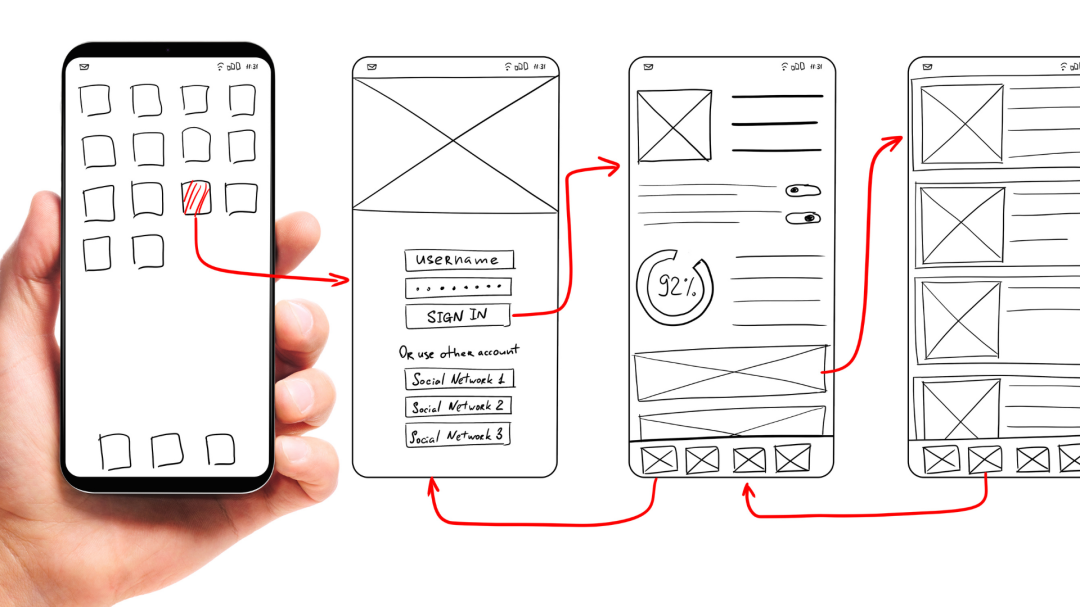What is a hybrid application?
A hybrid application is essentially a web app, but with a native app “container” that allows you to take advantage of certain features of the native platform and device hardware. For example, with hybrid application development, you’ll be able to access a mobile camera, calendar, push notifications, among others that a web app would not be able to access.
Like web apps, hybrid apps are built with commonly used front-end technologies and development languages such as JavaScript, HTML5 or CSS, which gives them cross-platform functionality.
Hybrid apps are available through app stores, can be accessed from your mobile and are installed, just like a native app. But how do they compare to native and hybrid apps, and what are their advantages?
Native vs. hybrid app
The main difference between native and hybrid apps is that native apps are built from the ground up for a specific operating system, while hybrid apps are built to support multiple platforms.
Overview of native apps:
- Built for a specific mobile operating system (e.g. Apple iOS, Android).
- Have access to all advanced native features of the target mobile device
- Better performance and security
- Need to re-code in a different language to port to a different device ecosystem (e.g. Swift or Objective-C t for iOS, Java for Android)
- Easier to comply with Apple App Store or Google Play shop requirements
- More expensive to develop
Overview of hybrid applications:
- Built with web technologies (e.g. HTML, CSS and JavaScript).
- Can achieve native performance with frameworks such as React Native (by compiling your JavaScript code, you could argue that it is technically a native app)
- Achieve higher developer productivity through cross-platform compatibility
- Lower development costs than native apps
- Support enough native features to run offline.

Examples of hybrid applications
While early hybrid applications were quite slow, advances in web technologies and frameworks have narrowed the gap between hybrid and native performance. Some examples of high-performance hybrid applications include

Gmail – Angular
Yes, the most popular email client is technically a hybrid app. The platform uses JavaScript, AJAX, jQuery and Vue.js on the front-end.

Twitter – React Native
Twitter boasts of its front-end technology stack with Node.js, Express and React Native. To be more specific, it is technically a Progressive Web App (PWA), a type of next-generation mobile website that offers superior UI performance, through progressive loading of UI layers. This ensures that the core content of your app is available to users with poor connections.

Instagram – React Native
Instagram’s timeline is technically a web view, which places it firmly in the hybrid app camp. The most popular social media platform is built with React Native.

Uber – React Native
Uber uses Base, a React UI framework for the front-end of its mobile apps that basically run on m.uber.com to provide a web view on your phone.

Untappd – React Native
The famous beer rating app runs on Ruby on Rails and other web technologies. Not surprisingly, it also uses React Native for that cross-platform compatibility.
Advantages of hybrid apps
The main advantages of hybrid apps are:
Cross-platform compatibility
Hybrid app frameworks allow developers to use a common code base on both Android and iOS devices.
Shorter development time
Increased code reuse reduces the development time it would take to create native apps for different operating systems.
Scalability
A single code base and cloud-native web technologies make it easier for developers to scale their applications.
Cost-effectiveness
Significant development cost savings in creating multiple versions of the same application for different operating systems.
Bridges can be used to make hybrid/native mixes.
When you scale a product, there may be some isolated cases in which hybrid development is not enough. In that case, what will be done is to code in native and “join” it with the hybrid by means of a bridge. This way you can use the best of each operating system, without the need to program 100% native.

How are hybrid applications created?
Hybrid application development is all about getting the right mix of native and web development technologies to bring your application to life. In a traditional hybrid application, the core application code is written using HTML, CSS and JavaScript web technologies, which is then encapsulated in a container called a webview. More recently, new cross-platform application development frameworks, such as React Native, also allow JavaScript to be compiled into machine code for native performance.
Overview of tools and technologies used to build hybrid apps:
Popular tools for building hybrid apps
While native iOS and Android apps are ideal because they are optimised for each platform, hybrid mobile app technology is evolving, making them a more viable – and cost-effective – option for mobile app development. Hybrid apps are able to get closer to a native app experience thanks to powerful frameworks that have addressed some of the limitations of hybrid apps.
Hybrid mobile application frameworks make quick work of application programming, just like traditional web application programming frameworks. They contain code libraries, APIs and other features to make coding your app faster and easier. There are web-based frameworks, which use front-end technology such as HTML, JavaScript and CSS, and cross-platform frameworks, which take a programming language and turn the code into native code for the device.

Frameworks for hybrid apps
A big attraction of hybrid app development is the ability to write the code once and use it on all mobile devices. Here are some of the most popular hybrid frameworks.
React Native
There’s a reason why many of the largest and most successful hybrid apps use React Native in their front-end technology stacks.
Developed by Facebook, React Native compiles its code base into native code. This means you have the option to use native views instead of the traditional web view of most hybrid app frameworks. Code reuse is limited to mobile platforms, as React Web requires some tweaking to adapt to mobile devices.
Angular
Navigation is very dynamic and allows the creation of complex applications that work in web view and run on all devices regardless of platform or system.
One of the great advantages of Angular is that its creator is Google, so continuity and the development community is more than guaranteed. This makes this system one of the favourites for app development.
Ionic
Ionic is one of the most popular hybrid app development frameworks. It uses the traditional web view approach to hybrid app development, where web-based source code is encapsulated within a web view that can interact with certain native APIs exposed through plugins.
Cordova
A single-page application (SPA) runs inside an embedded mobile web browser, essentially a web view. Plugins allow access to native functions as needed.
Xamarin
Xamarin is Microsoft’s answer to hybrid application development frameworks. You can write your applications in C# and get full access to the benefits of the .NET development ecosystem. Xamarin has a higher learning curve, but its C# wrappers can produce native performance without sacrificing code reuse.
Flutter
Flutter is a newcomer to the hybrid application development scene. It uses the Dart programming language, which combines the faster development cycles of dynamic languages that use just-in-time compilation (JIT) with the stability and execution speed of static languages that use compile-ahead (AOT). The result is a flexible framework that can achieve native performance with AOT and web interoperability with JIT.

Conclusion
At DigizoneLabs, we promote the use of hybrid technologies whenever possible, especially React Native for mobile applications and React for web applications. At the end of the day, this translates into both economic savings and considerable time savings when developing, without any need to lower the quality.
You can visit our portfolio and you will see the amount of mobile and web applications we have developed with these technologies. Besides, these technologies are very popular among the community of programmers, and this is very important because it means that they are very updated and well maintained technologies.
If you are thinking of setting up a new project, want to scale the one you already have or simply want to create another product within your company, do not hesitate to contact us and we will advise you on the technology that best suits you.









